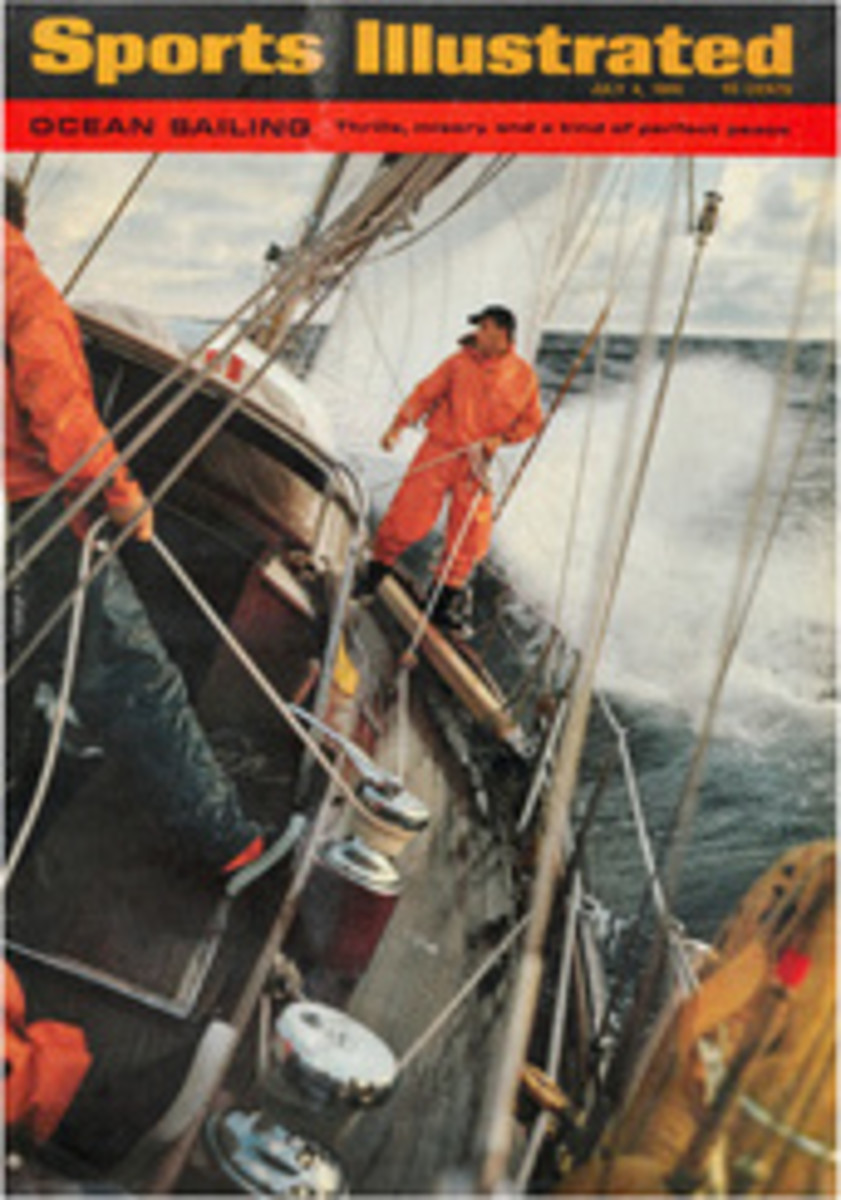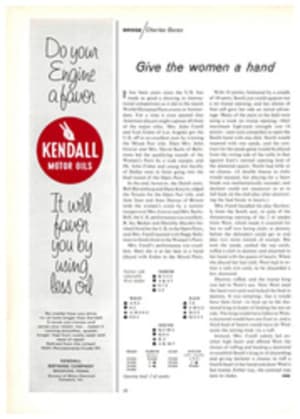
A HIGH FASHION MODEL TAKES OVER
Like those of a woman's skirt, the lines of an ocean-racing boat are dictated by fad, fashion and new materials—and nothing sets a style quicker than winning races. Some people laughed back in 1954 when Carleton Mitchell first unveiled his chubby, comfortable little yawl Finisterre and called her a racer. No boat so dowagerlike, they said, could possibly get out of her own way, let alone win a race. But even before Finisterre had settled down to one of the most monotonous series of wins in the history of ocean racing (she won the Newport-Bermuda three times, the only boat ever to do so), the scoffers had begun urging their own naval architects to duplicate her lines.
In the case of Finisterre, whose form was conceived in the inspired brain of Designer Olin Stephens and whose every plank was placed with meticulous care by Boatbuilder Seth Persson, such duplication was not easy, though imitations were plentiful. Today's envious owner-skippers are luckier, for the winningest racing boat on the ocean scene right now is a mass-produced, one-design fiber-glass stock job that pops out of a mold as much like her sister ships as two Ford Mustangs.
The boat of the 1960s is known generically as the Cal-40, and her collective racing record is spectacular. In the first year that the class appeared, a Cal-40 called Conquistador beat all the famed custom-built old-timers around the southern circuit. Next year a handful of Cal-40s set sail across the Pacific in the 2,225-mile Los Angeles-to-Honolulu race. One of them, Don Salisbury's Psyche, came in first overall, another placed second and another sixth. Early this year, for the second time, another Cal-40 (Ted Turner's Vamp X) won overall in the prestigious SORC. In the Cape May-to-Newport race last month, Cal-40s finished first and third in their class.
This sprightly, 40-foot race-winner was conceived on the drawing board of a West Coast sailor who believes in long silences, light displacement and a minimum of false modesty. "The Cal-40," says 46-year-old Designer Bill Lapworth, a transplant from Michigan to Newport Beach, Calif., "goes a whole lot faster than other boats." Which is exactly what he and George Griffith, who instigated the design, and Jack Jensen, who builds the boats, had in mind when they first got to work.
Lapworth has never tank-tested a hull in his life, and he doesn't care a fig for the rule-beating tricks that build a low handicap into a boat. "Rating" is what racing men call the magic formula that balances a boat's waterline length against her sail area and other factors in an attempt to make her equal to other boats. Most designers are constantly aiming at a low rating, but, says Lapworth, seeming almost embarrassed as he stares at his feet and smiles shyly behind horn-rimmed glasses, "We never looked at the Cal-40's rating until we got the first boat built." Well he might look embarrassed for, as it turned out, the Cal-40 rates a good two feet more than most boats her size, and this in a cutthroat game where half a foot can mean winning or losing. The thing is that the Cal-40 wins anyway.
One of the tricks that make this possible is the unusual design of her under-body. In profile (left) the Cal-40 looks more like an F.A.O. Schwarz toy designed to sail across the lake in Central Park than a real ocean racer. As in the Schwarz toy—and for somewhat the same purpose—her deep keel is widely separated from a so-called "spade" rudder that hangs independently well aft. This arrangement, which has already been widely imitated, is Lap-worth's method of providing fingertip steering control with a minimum of drag and thus doing away with many of the drawbacks generally associated with a lightweight boat.
For years designers have been arguing on the ocean, in testing tanks and on drafting tables over the relative merits of boats built with the solid substance, curvaceous lines and sensuous aspect of a Sophia Loren and boats constructed more along the angular lines of a high-fashion model. Everything about and aboard the Cal-40 is aimed at paring her weight to a minimum. Neither Designer Lapworth nor Builder Jensen of Costa Mesa, Calif. will consent to any owner's request for alteration of design that adds an unnecessary ounce to her bulk. But sheer lightness can be a drawback as well as an advantage.
The speed of a sailboat is achieved for the most part through a combination of waterline length and sail area. Lapworth gave the Cal-40 nearly two feet more waterline than any comparable boat, piled 700 square feet of sail on her rigging and hung three tons of lead on a short, deep, fin keel to counterbalance it when the wind is up. Then, to keep his boat from spinning on her sharp keel like a ballet dancer on one toe, he hung his spade rudder out aft like the last ventral fin of a Wahoo, where it could exert the most leverage with the least effort and still substantially reduce what designers call "wetted surface."
In simple language, wetted surface is that part of a hull that ruts against the water producing friction and drag to slow the boat down. Bill Lapworth has no use for anything, below the waterline or above it, that will slow his boats down. Unlike Mitchell's Finisterre, which was specifically designed to achieve her speed while still providing a maximum of below-decks comfort for captain and crew, the Cal-40's accent is entirely on speed. There is a stark absence of hand-polished tables, chrome shower baths, fancy ice-making machines and other gadget by aboard, but the backs of settees are precisely angled to counteract fatigue and thus keep a crew in top shape.
This businesslike approach is followed in every inch of the design. In most boats, the transducer element of the depth-finder hangs in the water under the bottom providing some—not much, but some—drag. The Cal-40 puts the transducer in a little ocean of its own—a box of water inside the boat. The electronic effect is the same; the drag is nil.
In other boats, toilet drains, intake valves and other fittings that must go through the hull all stand out an eighth of an inch or so and thus create drag. On the Cal-40 these fittings are sunk flush with the surface of the hull. Even the automatic bilge pump is designed so that the water it pumps out flows into the cockpit and over the feet of the crew before it runs overboard through special drains. Clammy as this may sound, there is good reasoning behind it. "If there's water in the bilge, we want the crew to know about it," says Jensen Executive Charlie Thomas. "People don't like this, and a customer will say to us, 'Let's run it over the side anyway.' But we won't do it. It's a safety factor."
Like the settee backs below, the coamings that line the cockpit seats and against which the crew may have to lean for long hours at sea are angled for efficient comfort. Cleats and winches are installed at carefully studied positions and are tilted so sheets and other running rigging can be made fast at the best possible points. The top of the cabin is set at the right height for the man on deck, not the man below—low enough so the helmsman gets an unobstructed view all the way forward. "You may not have a lot of headroom below," says a Jensen man, "but you have plenty of visibility topside."
Just as Finisterre, now an old-fashioned kind of ocean racer, was built for comfort and achieved speed, the Cal-40, product of modern mass-production technology, is built for speed and achieves a certain comfort and luxury of its own. Old Nat Herreshoff, who built some of the finest wooden boats in the history of the sea at Bristol, R.I., might blanch if he saw these gleaming white wonders of fiber glass pop out of their clamshell molds, but even Captain Nat with all his know-how and the cheap labor of his day could not have duplicated the $27,500 Cal-40 at any price 50 years ago.
The Cal-40 is doing more than winning ocean races. It is changing the whole ocean-racing picture.
ILLUSTRATION
TWO ILLUSTRATIONS
Helmsman's view [left] shows the clean design of the Cal-40 cockpit and the carefully angled winches. A new hull is shown below ready to be taken out of its clamshell mold.

